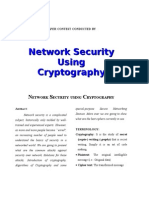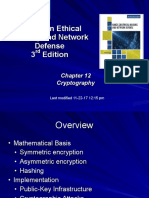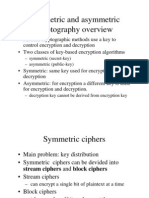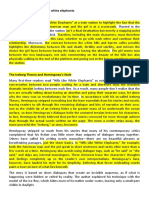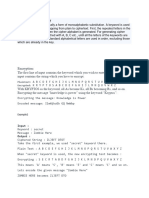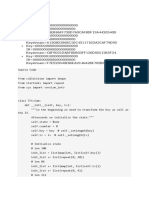Cryptography
Uploaded by
Damian Alejandro SalinasCryptography
Uploaded by
Damian Alejandro SalinasPublic
Two keys
Private
Trap Door Functions Very Difficult to factor large prime numbers
Certificates used to
Key Transfer PKI Authority
verify sender
Process to Generate Key Pair Relies
EX: Try to factor 100,160,063
heavily on semi-prime numbers that
Rives Shimear without any help....
are difficult to factor
Adlemen (RSA)
Use at least a
Preferably 4096
2048-bit key
1) User 1 Generates key P1 = K1 * F
2) User 2 does same as above
Utilizes property of elliptic curves where two points 3) User 1 can send User 2
Process S = K1 * P2
added can generate a third point on the curve message via shared secret
Elliptic Curve 4) User2 can generate same
S = K2 * P1
Cryptography shared secret independently
(ECC)
Criticism Lack of analysis
Used in mobile devices
with the AES algo
One key cannot be derived from having Benefits Low computing power
Perfect forward secrecy
possession of another key Can work with
lower sized keys
TCP/IP layer 4
Transport - Encryption Made in 1975 First one
SSL/TLS
Only a methodology for two parties to come up with the same session key Key Exchange Protocol
Sender and
Receiver is Non-repudiation Works by obfuscating based
Cryptographic Objectives off really hard discrete
EX: 3^? mod 17 =
verified 2314692094782383457
log problems
Hands key to third party
Group 1 748-bit modulus
Retrieve private key to decrypt Used for law Diffie Hellman
data needed in court enforcement Key Escrow Group 2 1024-bit modulus
Group 5 1536-bit modulus
Retrieve data in the situation where data
Used by corporations
holder is no longer present Diffie-Hellman Groups Group 14 2048-bit modulus
Asymmetrical Group 19 256-bit ECC
Can tell very easily if data
Measure data disruption
has been intercepted Group 20 384-bit ECC
Quantum Cryptography
Prime factorization is Group 21 521-bit ECC
Obsolete RSA, Blowfish, RC4 Cryptanalysis
nothing for a quantum cpu Algos
Originally Made to
Hiding messages encrypt email
Ensuring integrity Purpose 1) Generate
Random Key
Verify source
Relies on the random key that is
2) Encrypt Data with key
generated by the sender
Breaking codes
3) Encrypt Key
Key retrieval Concepts using receivers key
Brute force Phil Zimmerman came up
Trying to Cryptanalysis with this by himself.....
Try to determine determine
Differential
key for encryptions by comparing input to output cipher text plaintext "PGP Certificates"
Uses simplified cipher to discover No big companies
Linear
full key through heuristics or hierarchal structure
Generates a
Relies on each users
Art of hiding messages in images "web of trust" (Originally)
due dilligence
Non-Suspicious Medium creates PGP/GPG Usually just PKI now
barrier to initial analysis Stegonagraphy
Bit locker
Determine the offset that will not Least-Significant Bit
cause disruptions in image (LSB) encoding Filevault
Encrypt mass storage
Symantec Corporation Enterprise/Cloud
Use of cryptographic hashes to Uses special certificates solution
verify the authenticity of a
message or software
Signing
Typically Used in
Free
Asymetric Encryption
Cryptography OpenPGP PKI support
Works without
Unsigned Certificates
third party Email only
Done by getting signatures Linux based
from other people version of PGP
Digital Signatures GPG
Highly complex Web of Trust Other services
then email
Almost never used
in web browser
Shared secret method
Top is
certificate Key must be
authority transferred
Public Key Key management is
Hierarchal Method extremely important securely
Medium intermediate Infrastructure
certificate authoroity Key must be complex
Last are users
1) Generate 64 bitKey
Electronic Code 2) Permutate Key
After a certain length patterns can be found
Books Have Issues
3) Split off 48 Bit Subkey
Add an initial vector
Split Main Key
Cipher Block Chains (CBC)
Each block 4) Feistel Function into two 32 bit
gets a new key Process
3DES XOR Halves with subkey
Encrypt
5) Apply s-boxes
initialization
Vector 6) Encrypt Data
Cipher Feed Back
XOR to the first block 7) Repeat 15 times
Block Chain (Normal DES) or 45 times (Triple DES)
Recycle last piece of
block and encrypt Block Cipher
Symmetric
NONCE and COUNTER Symmetric Block
Encryption
NONCE is fixed Algos
128-bit Symmetric Block
COUNTER increments AES
CTR Key Size can either be
Add both NONCE 128, 192, or 256 bits
and COUNTER
Rounds can either be 10, 12, 14
Encrypt data and then respective to Key Size
increment COUNTER
64 Bit Size
Symmetric that is used for authentication Blowfish Size anywhere from
for the duration of a session Uncontrollable
32-bits - 448-bits
Session Keys
Auto generated Twofish
through random seed
1 bit at a time
Used once and Stream Cipher
(i.e. a Token)
only once
Ephemeral keys 1 Round
RC4
Key Size is anywhere from
40-bits - 2048-bits
Fast and few
requirements
Ensures integrity of messages
1 - Way
Encryption Passwords
Method Uses
Image Matching
Cryptanalysis Collision attacks
MD5 Can generate Collisions
Hashing 1 160 bit hash Can generate collisions
2 256 bit hash
SHA 5 512 bit hash
Algos
Not really used
RIPEMD
Bit versions 128,160,256,320
Requires a
HMAC
symmetric key
You might also like
- Cryptography: CISSP Guide To Security EssentialsNo ratings yetCryptography: CISSP Guide To Security Essentials51 pages
- Network Security - Cryptography: AbstractNo ratings yetNetwork Security - Cryptography: Abstract11 pages
- Public-Key Cryptography: Montclair State University CMPT 109 J.W. Benham Spring, 1998No ratings yetPublic-Key Cryptography: Montclair State University CMPT 109 J.W. Benham Spring, 199820 pages
- Public-Key Cryptography: Montclair State University CMPT 109 J.W. Benham Spring, 1998No ratings yetPublic-Key Cryptography: Montclair State University CMPT 109 J.W. Benham Spring, 199820 pages
- Networksecurity & Cryptography: Bandari Srinivas Institute of TechnologyNo ratings yetNetworksecurity & Cryptography: Bandari Srinivas Institute of Technology10 pages
- Notes On Network Security Issues: From Security Courses At: Stern School of Business, NYU Georgia Tech100% (4)Notes On Network Security Issues: From Security Courses At: Stern School of Business, NYU Georgia Tech59 pages
- 02-CH02-CompSec2e-ver02 Cryptographic Tools PDFNo ratings yet02-CH02-CompSec2e-ver02 Cryptographic Tools PDF36 pages
- Computer Security and Cryptography A Simple PresentationNo ratings yetComputer Security and Cryptography A Simple Presentation22 pages
- Week 3 - 4 - CH02-Cryptographic Tools-2-3No ratings yetWeek 3 - 4 - CH02-Cryptographic Tools-2-342 pages
- Public Key Infrastructure: Securing The Future of Communication Bit by BitNo ratings yetPublic Key Infrastructure: Securing The Future of Communication Bit by Bit24 pages
- Cryptography and Network Security: Sixth Edition by William StallingsNo ratings yetCryptography and Network Security: Sixth Edition by William Stallings40 pages
- Basic Guideline of Soldering For Beginners CompressedNo ratings yetBasic Guideline of Soldering For Beginners Compressed16 pages
- The Great Gatsby (Themes, Motifs, Symbols,)No ratings yetThe Great Gatsby (Themes, Motifs, Symbols,)12 pages
- Ernest Hemingway, Hills Like White ElephantsNo ratings yetErnest Hemingway, Hills Like White Elephants5 pages
- The Intelligence Technology and Big Eye Secrets: Navigating The Complex World of Cybersecurity and EspionageNo ratings yetThe Intelligence Technology and Big Eye Secrets: Navigating The Complex World of Cybersecurity and Espionage738 pages
- Unit 1 Cryptography and Cyber Security NotesNo ratings yetUnit 1 Cryptography and Cyber Security Notes52 pages
- PSMPA: Patient Self-Controllable and Multi-Level Privacy-Preserving Cooperative Authentication in Distributed M-Healthcare Cloud Computing SystemNo ratings yetPSMPA: Patient Self-Controllable and Multi-Level Privacy-Preserving Cooperative Authentication in Distributed M-Healthcare Cloud Computing System8 pages
- INDUS 2024-2025 Security Refresher TrainingNo ratings yetINDUS 2024-2025 Security Refresher Training51 pages
- Confidentiality Using Conventional Encryption100% (1)Confidentiality Using Conventional Encryption3 pages
- 1.2 Installation of SSH Keys On Linux-A Step-By Step GuideNo ratings yet1.2 Installation of SSH Keys On Linux-A Step-By Step Guide3 pages
- Modular Arithmetic, Bar Codes and Ciphers: Topic 1No ratings yetModular Arithmetic, Bar Codes and Ciphers: Topic 110 pages
- Security System For DNS Using CryptographyNo ratings yetSecurity System For DNS Using Cryptography14 pages
- NatalieLarsen CYB300 MilestoneTwoChecklistNo ratings yetNatalieLarsen CYB300 MilestoneTwoChecklist2 pages
- IEEE - Analysis of Ransomware Attack and Their Countermeasures A ReviewNo ratings yetIEEE - Analysis of Ransomware Attack and Their Countermeasures A Review7 pages
- Cryptographic Security in Military Radio CommunicationsNo ratings yetCryptographic Security in Military Radio Communications7 pages

















